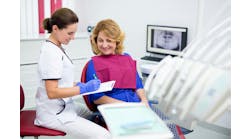by Jeff Carter, DDS
Many motivators provide the impetus for doctors to consider the purchase of new clinical dental equipment. My perception at times is that accountants are the final arbiters in determining when doctors will make a significant equipment purchase. Recent federal tax credits and advantageous depreciation schedules have encouraged many doctors to participate in late-December purchasing frenzies. These panic-driven purchases often result in acquisition of equipment that remains “in the box” for months, if not years. Trendy technology items are very popular late-December impulse purchases. Many doctors have purchased CCD intraoral digital X-ray sensors or phosphor-plate scanning systems - which were ultimately delivered to facilities with two front-desk computers on Windows 98 and a consult room tube-TV - with a built-in VCR.
What can you do to avoid purchasing missteps and untimely investments? Consider the following five guidelines and develop a purchasing plan and schedule based on your current needs and future growth and development goals.
1. The three-month rule
Tax implications of equipment purchases are significant and should be factored into the decision-making process in a timely manner. Meet with your accountant midyear to track your practice income and estimate end-of-year tax implications. Allow three months to research, view demonstrations from viable vendors, and review pricing quotes before making major equipment purchases of more than $20,000.
The actual time spent before the decision to purchase or not purchase may total only three or four hours, but it is unfeasible to organize research materials, schedule vendor demonstrations, visit trade show exhibits, and review pricing quotes in a week or two. In addition, you may need time to upgrade existing systems in your current facility to utilize the newly purchased unit.
Types of equipment in the $20,000-plus category can include digital radiography systems, CAD-CAM milling units (CEREC by Sirona), panoramic X-ray units, cone-beam technology (iCAT), practice management and clinical management software, and hard-tissue lasers. Interestingly, these higher investment products can also be considered in the category of “high-tech” dental equipment. The complexity of options and utilization parameters of these products has evolved so far beyond the traditional equipment decisions dentists faced 10 or 15 years ago that it is staggering.
2. Investing in core dental function vs. trendy developments
Most last-second impulse purchases involve the latest gadget to create a “buzz” in the profession. Trendy products have a mixed record of success in long-term use and value. Investments in the “less-glamorous” category of core dental function can be a safe and wise investment in the future productivity of your facility. An easily understood analogy is how fathers and teenage sons maintain automobiles.
Sons invest the majority of their funds (and some of their parents’) in mag wheels and stereo systems that trigger seismic readings at the National Earthquake Center. Sons are unconcerned about the diminished supply of two-year-old oil semi-lubricating the internal moving parts of their engines. Fathers typically change engine oil and oil filters every 3,000 miles, periodically check to see if their tires have tread, and replace worn parts before they either explode or fall off the car at 80 mph.
Maintaining the core dental function of your facility begins with consistent and appropriate functional output from both the vacuum pump and air compressor. Fluctuating and low vacuum levels can prolong even the most basic procedures. Fluctuating air pressure can prolong and even compromise procedures due to inconsistent torque and bur speed.
▲ Consider this hypothetical scenario: Your accountant advises you in September (not on December 15) that it is financially advantageous to purchase new equipment this calendar year. The vacuum pump in your facility is 15 years old and uses a water-driven impeller to create suction. Your air compressor is only 10 years old and looks great, except the leaking oil occasionally mixes with the air/water syringe spray in your operatories during composite and bonding procedures.
You make the “safe” decision to invest approximately $5,000 in a new Air Techniques oil-less compressor that provides increased performance output and delivers uncontaminated compressed air to the operatories. Your second “safe” investment is approximately $6,000 in a RAMVAC Bulldog QT E-Series Combo 2 “dry” vacuum pump. In time, you discover the new “dry” vacuum pump reduces your facility’s water utility bill by $50 per month.
Currently, your staff uses a hand-held spray canister to lubricate and flush pneumatic handpieces. In addition to the nuisance of excess lubricant coating the sterilization area countertops, you sense that you are replacing handpieces more often than your study club buddies. Another investment in core dental function that can improve handpiece performance and longevity is a handpiece lubrication unit.
Two great purchase options are the A-dec Assistina and the KaVo QUATTROcare. You decide to invest approximately $2,300 in the KaVo unit, which has the capacity to service four handpieces at one time which is ideal for your busy practice.
At a trade show, you “test drive” an electric handpiece and are amazed at the torque and cutting speed it delivers. To supplement your pneumatics, you invest another $5,000 and purchase two KaVo electric handpieces.
In spite of the addition of a new vacuum pump and compressor, operatory No. 3 is your and the staff’s least favorite treatment room. It seems as though most of the problematic procedure outcomes occur in this operatory.
An examination of the 15-year-old delivery unit reveals multiple problems, including the unit’s capacity to maintain compressed air levels and appropriate water spray to high-speed handpieces. You invest approximately $4,900 in a Pelton and Crane Spirit 2000 Flexible Delivery Cart. This now becomes your favorite treatment room.
Now that you are focused on improving the core dental functioning of your office, you declare that dull burs are as detrimental to treatment delivery as low air pressure and faulty delivery units. You decide to invest $2,000 and bulk-purchase multiple burs in a special deal from Brasseler. Your accountant informs you that burs fall into the category of consumable materials and supplies and can be entirely expensed in the year purchased, regardless of the federal tax credit status of equipment.
In this scenario, total investment in core dental function equipment for the year is $23,200. Taken as a tax credit, the entire amount may be expensed in the year purchased, versus depreciating the amount over five to seven years.
While visiting your study club buddy’s office, she shows you the box containing her new, accountant-inspired purchase of a $21,000 phosphor plate scanning system. You admire how well the scanning unit is packaged in Styrofoam, which ensured undamaged delivery to the office - four months ago.
3. Equipment discounts and trade show specials
I have written about this topic several times and I am always surprised that most doctors remain unaware of the typical pricing structure and product distribution logistics for major pieces of dental equipment.
Manufacturers such as A-dec, Pelton and Crane, Air Techniques, and Sirona distribute their products through networks of resellers. Many manufacturers are very cautious about which resellers they approve to sell and service their products.
Resellers include companies such as Patterson, Sullivan-Schein, Benco, Burkhart, and many others. Doctors cannot purchase equipment directly from manufacturers in this distribution model.
Resellers are able to acquire equipment from the manufacturers at a reseller discount, and then “resell” the equipment to you at cost. Occasionally, the reseller cost to you is the established retail price set by the manufacturer. More frequently, the reseller cost to you represents a significant discount off the established retail price, typically in the range of 22 to 24 percent. For example, the Progeny Previa DC intraoral X-ray unit lists at retail for $5,285. A doctor purchasing this unit invests $4,016 - a 24 percent discount.
When reviewing an equipment proposal from a reseller, assume most equipment items will be priced in a range of 22 to 24 percent below retail. If you’re at a trade show and the “trade show special” is a piece of equipment discounted 20 percent off retail, then it may not be a good deal at all. If the “trade show special” discount is higher than 24 percent, you may have secured a good or even a great deal.
Retail pricing for most major dental equipment is known in the marketplace through various information sources. It would be unlikely for high-profile resellers to inflate the retail price in order to present a higher and seemingly more attractive discount option.
Great deals can occur when a manufacturer lowers the equipment cost to the resellers in an effort to reduce inventory and the reseller passes that savings to you, or resellers choose to reduce their “margin” and discount greater than 24 percent to make the purchase more attractive to you.
As confusing as the reselling/discounting business model may be to you, it is a legitimate marketing tool and commonly used in many other markets outside dentistry.
4. New facility equipment purchases and “free design”
There are 254 IKEA stores in 34 countries, including 34 locations in the United States. To quote their Web site, the IKEA business idea is to offer a wide range of home furnishings with good design and function at prices so low that as many people as possible will be able to afford them - and still have money left!
Walking along the meandering IKEA pathway, you tour model spaces displaying a myriad of home furnishings. At least once during each visit I’ve made to an IKEA store, I am startled by the seemingly low price of an item that appears well designed, highly functional, and really cool. On my last visit, I noticed a banner above an unbelievably low-priced sofa with a quote from the founder of IKEA. It read, “If you cannot put a price on something, it has no value.” To many, the quote could be interpreted as Draconian and that cannot possibly be the intent.
This concept can even be applied to your dental practice, as many of you offer to fix this or patch that for free, thinking the good deed will be returned to you through new referrals or whatever. The unfortunate reality is that whatever you provided for free is probably perceived by the patient as valueless or you would have charged for it. And you have devalued the procedure by tacitly declaring that it is of no value.
All of this seemingly unrelated background information brings us back to the most equipment-intensive purchasing event in your practice career - the designing, constructing, and equipping of a new facility. How many of you have been presented with this option during your quest for a new office? “If you purchase all your equipment through us, we will design your office for free.” If you believe the founder of IKEA, free design is of no value and, if it was, it would have a price attached. I have also written about this apparent design service contradiction many times and yet almost daily I encounter doctors who believe the design of their new facility should cost them $0.
In reality, “free design” is funded through reduced equipment discounts below the typical 22 to 24 percent range. With this option, you never know what you actually invested in design through your equipment purchases.
Dissatisfaction with the facility outcomes of “free designers” is muted by doctors’ perceptions that at least they did not have to pay for the service. Offerings of free office design declare that the design of your office is of no value. After working in the design world for many years, I disagree.
5. Re-read items 1 through 4
Best regards and enjoy your dentistry!Dr. Jeff Carter is co-owner of the Practice Design Group, based in Austin, Texas. PDG specializes in providing architectural, interior design and equipment, and technology integration services to dentists nationwide. Dr. Carter may be contacted by phone at (512) 295-2224, by e-mail at [email protected], or by visiting PDG’s Web site at www.practicedesigngroup.com.







